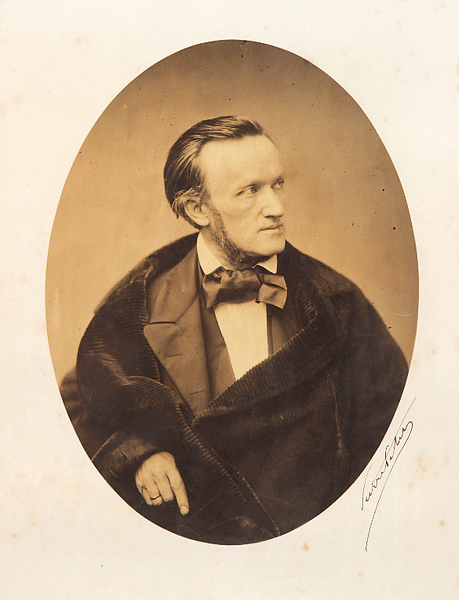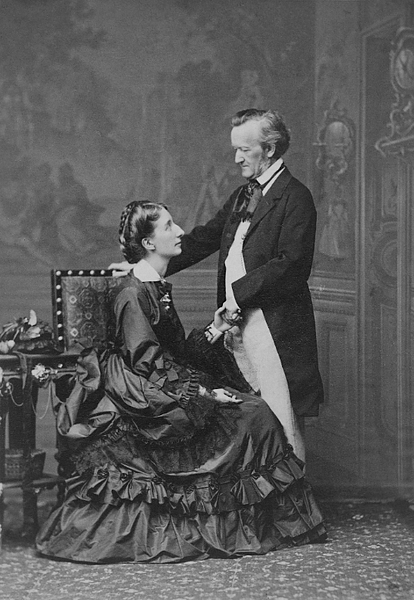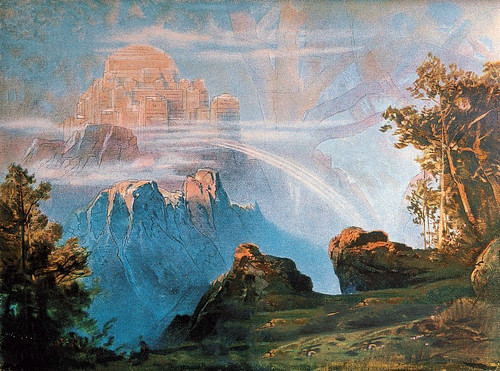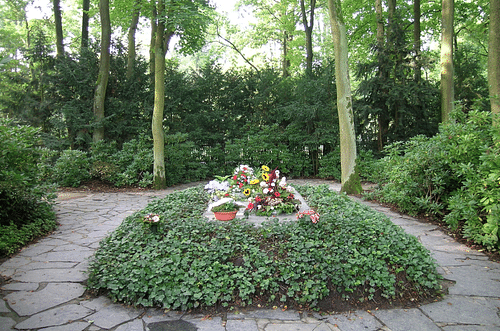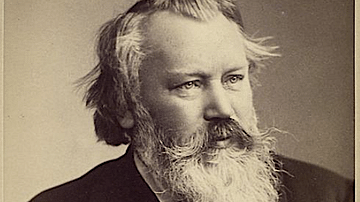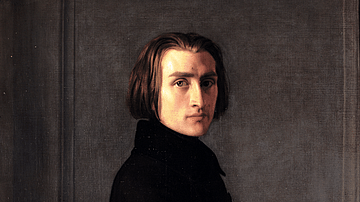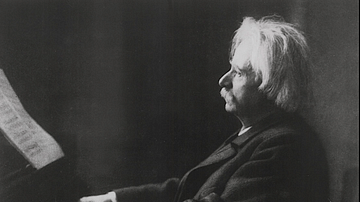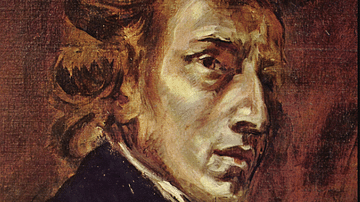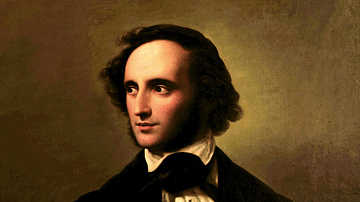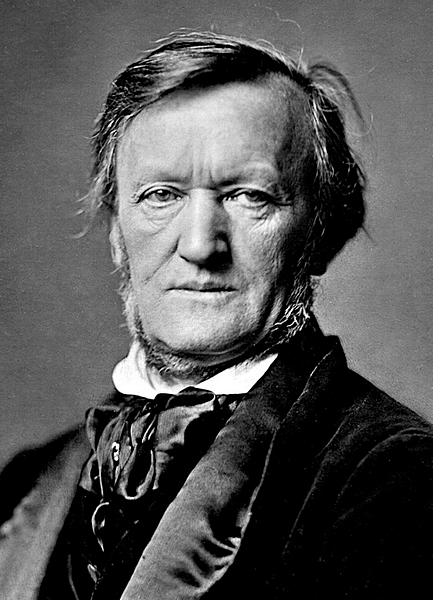
Richard Wagner (1813-1883) was a German composer of Romantic music most famous for his epic operas like The Ring, Tannhäuser, and Tristan and Isolde. Wagner was concerned throughout his career with the theme of redemption through love and with presenting what he called 'total artworks', where music, poetry, and drama were uniquely combined into a single performance.
Early Life
Richard Wagner was born in Leipzig on 22 May 1813. Within months, the infant Richard lost his father Carl Friedrich Wagner, a police actuary, to typhus. Richard's mother Johanna, the daughter of a baker, then married the painter Ludwig Geyer, who encouraged the young boy to pursue a career in music. Johanna and Geyer had long been conducting an extra-marital affair, and some historians suggest that Geyer was actually Wagner's father. Geyer was of Jewish descent, an irony given Wagner's later views on race.
The family moved to Dresden where Richard met another big influencer on his career, the conductor of the Royal Theatre, Carl Maria von Weber (1786-1826). When Geyer died, Richard and his mother moved back to Leipzig, and the young man joined the university there in June 1830. He studied musical theory under Theodor Weinlig but, unlike many other great composers, never actually learnt to play any instrument with any degree of proficiency. After graduation in 1833, he secured a position in Würzburg as a chorus master and then became the musical director of a travelling theatre company. It was the field of opera that really inspired the young Wagner, even if musically, he held the Ninth Symphony by Ludwig van Beethoven (1770-1827) in highest esteem.
A European Migrant
In 1837, Wagner moved to Riga where he found work as a conductor, but he found himself in so much debt that he was obliged to leave in March 1839. He lived for a while in London before moving to Paris in September 1839. Unable to make a living with his music, Wagner turned to journalism and orchestration for other musicians, but his lack of sense with money soon saw him rack up creditors again, so much so, the would-be composer briefly became acquainted with the interior of a debtor's prison. He left Paris for Dresden in 1842, where he again found work as a conductor from 1843.
In 1849, Wagner was obliged to leave Dresden following the popular uprising in May which he had publicly supported. With a warrant for his arrest in Germany, Wagner settled in Zürich, Switzerland, where he continued to compose. He also began to set out his views on opera in essays, where he described his vision for a new approach where music and drama become inseparable. In 1849, he wrote his essay Das Kunstwerk der Zukunft (The Artwork of the Future), and in 1851, he wrote Oper und Drama (Opera and Drama).
In 1853, Wagner started working on his career-defining The Ring opera cycle. This was a massive project involving four epic dramas, and it would not be completed until 1876. Returning to Germany in 1860, Wagner moved around to avoid his more persistent creditors. Financial freedom was finally gained in the mid-1860s when the composer secured the patronage of King Ludwig II of Bavaria (r. 1864-1886). Living in Munich and with all his debts cleared, Wagner was able to concentrate once again on composing, but eventually, the large sums of money Ludwig spent on his musical maestro meant that the Bavarian people began to protest. Wagner was once again obliged to move on.
Character & Family Life
The music historian C. Schonberg gives the following striking description of Wagner:
There was something Messianic about Wagner himself, a degree of megalomania that approached actual lunacy…He was a short man, about 5 feet, 5 inches tall, but he radiated power, belief in himself, ruthlessness, genius. As a human being he was frightening. Amoral, hedonistic, selfish, virulently racist, arrogant, filled with gospels of the superman (the superman naturally being Wagner) and the superiority of the German race, he stands for all that is unpleasant in human character…but his egomania was supported by genius, and after him music was not the same.
(296-7)
Wagner married the actress Wilhelmine (Minna) Planer on 24 November 1836. The relationship did not last long, for within six months Minna ran off with another man. Minna and Wagner did get back together in October 1837, but things were not quite the same again.

Around 1852, Wagner fell in love with Mathilde, the wife of a merchant, Otto Wesendonk – to add to the risk, Wagner was deeply in debt to Wesendonk. When Wagner's wife discovered the affair the composer moved to Venice, then Lucerne, and then Paris.
In 1865, the conductor at the premiere of Wagner's opera Tristan und Isolde was no less a figure than Hans von Bülow (1830-1894), but the meeting of the two musicians had consequences which went beyond their public lives. A third point in the triangle of what became a tangled affair was the composer Franz Liszt (1811-1886). Wagner's career had been promoted by Liszt, who conducted the premieres of several of his operas. Wagner and Liszt became good friends, but when Wagner had an affair with Liszt's daughter Cosima (b. 1837), who was married to von Bülow at the time, their relationship became strained. Minna Wagner died in 1866. Wagner then lived with Cosima in Tribschen outside Lucerne and they finally married in 1870. Eventually, Wagner and Liszt were reconciled. Wagner and Cosima had two daughters, Isolde (b. 1865) and Eva (b. 1867), and a son, Siegfried (b. 1869).
Showing that Wagner was a Romantic in every sense, he once conducted a group of musicians on his own doorstep to serenade Cosima in honour of her birthday in 1870. The piece selected by the composer was his own symphonic poem the Siegfried Idyll, named after the couple's son. The marriage, however, later suffered from Wagner's affair with the married Judith Mendès in the late 1870s.
Wagner's attitude to other composers was ambiguous. In an 1869 article, he viciously attacked the conducting skills of Johannes Brahms (1833-1897), but it was Wagner who managed the removal of the remains of von Weber (1786-1826) from London, where he died, to Dresden. With the exception of Beethoven, perhaps the only composer Wagner really admired was himself. Wagner once wrote, "I am the most German of beings. I am the German spirit. Consider the incomparable magic of my works." (Schonberg, 309).
The Wagner Operas
Wagner tried writing his first opera in 1832 but abandoned the project. Preferring to write his own librettos, he had a second attempt and completed his Die Feen (The Fairies) by 1834, although it was not staged until 1888. Wagner's third opera was Das Lieberverbot (Love's Interdict or The Ban on Love) based on the play Measure for Measure by William Shakespeare (1564-1616). The opera only managed a single performance, in Magdeburg in 1836, but this lack of success was more to do with the theatre company going bankrupt than any lack of merit in the opera. At least, thanks to his conducting duties at Magdeburg, Wagner was increasing his knowledge of German and Italian operas.
The opera Rienzi was partly written while Wagner was in Riga and first performed in Dresden's Hoftheatre in October 1842. The success of Rienzi allowed Wagner to pursue his vision of what modern opera should be. He was now inspired to delve into literature for potential libretto material, particularly stories from German folklore. He was especially interested in the legends of Lohengrin – the knight who searches for the Holy Grail – and Tannhäuser – the poet-knight who discovers the underground home of the goddess Venus.
In his epic operas, Wagner, inspired by such philosophers as Arthur Schopenhauer (1788-1860), was looking for a new kind of artistic presentation, one that combined music with other arts like poetry, painting, dramatic plays, mythological literature, and even philosophy and politics. This vision of a 'complete' or 'total' art form became known as Gesamtkunstwerk and was expressed in the composer's essays on the arts. Wagner's operas were also different in that they often provide very challenging roles, especially for the tenor and soprano roles. He also did away with arias as "unbroken drama expressed in unbroken music was his goal" (Schonberg, 302).
Wagner's new approach gained both admirers and critics. Wagner became "a destructive force, to some, and the ultimate hope of music to others" (ibid, 304). In the end, Wagner became the most famous composer in the world, but there were notable critics, many of them composers themselves or giants in their own field. Clara Schumann described the experience of watching a Wagner opera as like "wading about in a swamp" (Steen, 459), Leo Tolstoy described one Wagner opera as "a stupid Punch and Judy show" (ibid), while Virginia Wolf labelled Wagner's operas as nothing more than "bawling sentimentality" (ibid).
The opera Der fliegende Holländer (The Flying Dutchman) was completed in 1841, and its three-act libretto by Wagner based on Heinrich Heine's Aus den Memoiren des Herren von Schnabelewopski tells the tale of the Dutchman who, found guilty of blasphemy, is condemned to sail a ship until he is redeemed by a faithful woman. An extra catch is the wandering mariner can only make the attempt to find love once every seven years. The Dutchman is ultimately redeemed, by Senta, a Norwegian fisherman's daughter who proves her love by throwing herself off a cliff as the Dutchman's ship leaves port. This theme of redemption through love would preoccupy Wagner for the rest of his career. The opera was premiered in Dresden in January 1843; such was its success, Wagner was appointed the theatre's conductor.
The opera Tannhäuser und der Sängerkrieg auf dem Wartburg (Tannhäuser and the Song Contest at the Wartburg, usually referred to simply as Tannhäuser) was completed in the spring of 1845. The plot over three acts with words by Wagner has the poet-knight of the title seduced by Venus. He sings a song in her praise at the Wartburg song contest, which offends his fellow knights, who insist he seeks absolution from the Pope. The romantic interest is provided by Elisabeth, who, on hearing of Tannhäuser's plight, dies of a broken heart. Tannhäuser returns to Wartburg, sees Elisabeth on the funeral pyre, and then dies of grief. Pilgrims who have been to Rome arrive at the tragic scene with the Pope's staff and its miraculous sprouting of leaves, taken as a sign that God has forgiven Tannhäuser. The opera premiered in Dresden in October 1845.
The opera Lohengrin was completed in 1848. It premiered at the Weimar Court Theatre in August 1850 with great success. The three-act libretto, written by Wagner based on the anonymous legend of Lohengrin, tells of court intrigues in the kingdom of Brabant. The knight Lohengrin arrives on a boat drawn by swans and agrees to defend Princess Elsa in her claim to the throne provided she never asks his name or origins. Lohengrin defeats the nasty Telramund and marries Elsa. After another fight with Telramund, Lohengrin reveals to the court his name and that he comes from the Temple of the Holy Grail.
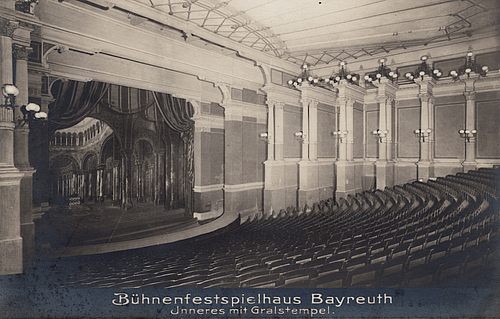
The three-act opera Tristan und Isolde (Tristan and Isolde) was completed in 1859, with both music and libretto by Wagner. The plot, which involves a doomed adulterous affair between the title characters may well have been inspired by the composer's own affair with Mathilde Wesendonk. Just like real life, the operatic affair all ends in tears. The opera was premiered at the Munich Court Theatre in June 1865.
The opera Die Meistersinger von Nürnberg (The Mastersingers of Nuremberg) was completed in the autumn of 1867. The three-act libretto by Wagner involves a singing competition in Nuremberg to decide who will marry Eva, the daughter of a goldsmith, and the various rivalries and intrigues between the contestants. The opera premiered in Munich in June 1868.
The operatic cycle Der Ring des Nibelungen (The Ring) was completed in 1874 but not performed complete until 1876. The work is composed of four epic dramas, meant to be shown over four successive evenings. Das Rheingold (The Rhinegold) acts as a prologue to the subsequent trio of three-act dramas: Die Walküre (The Valkyrie), Siegfried, and Götterdämmerung (Twilight of the Gods). The plot is "an allegory, and tells of the struggle for power between the Nibelung dwarfs, the Giants, and the Gods" (Arnold, 1571). There is a treasure of gold (the Rhinegold), a gold ring that gives its wearer mastership of the world, nine warrior goddesses called the Valkyries, the heroes Siegmund and Siegfried, a curse, a magic helmet, spear and sword, and a finale that ends with the burning of Valhalla, the destruction of the gods, and the birth of a new world of Love. The four parts cover some 12 hours of performance and are held together thematically through the use of musical motifs identified with specific characters and situations. The premiere was not without its problems – the vital ring was lost mid-performance and a cock-up with the scenery revealed all the stagehands at one point – but the opera has been a staple of the repertory worldwide ever since. It is considered Wagner's masterpiece.
Wagner's final opera was Parsifal, completed while the composer was in Palermo in Sicily in 1882. It tells a story involving the legendary healing powers of the Holy Grail. It was premiered in Bayreuth in the summer of 1882 to great acclaim.
Wagner's Innovations
Wagner was an innovative composer and even added brand-new instruments to the orchestra. For example, for The Ring, he commissioned new instruments to be made like the bass trumpet and the Wagner tuba, which bears his name. The composer was often keen to increase the sound of his orchestras, too. For example, for the finale of Das Rheingold Wagner employs six harps. Wagner was clearly a little particular about his instruments. He once said of the viola that it is "commonly played by infirm violinists or by decrepit wind players who were at one time acquainted with the violin" (Wade-Matthews, 108).
Wagner was also keen to influence theatre design and ensure audiences had an unimpeded view of the actors and the hall had excellent acoustics. To these ends, he made specifications for the architect Gottfried Semper to build the new Festspielhaus in Bayreuth, completed in 1876. The first production there was Wagner's Ring cycle, given before an audience of 4,000, which included the emperor of Germany, a handful of other European royals, and the world's press. The theatre continues today to host an annual Wagner festival.
Nazism & Antisemitic Views
Wagner was guilty of expressing antisemitic views in such pamphlets as Das Judenthum in der Musik (Jewry in Music, 1850). He not only attacked in words such Jewish composers as Giacomo Meyerbeer (1791-1864) but his writings also claimed that the German Aryans were descended from the Gods and that the taking up of their rightful place as rulers had been somehow impeded by the business activities of the Jews. In the next century, these views resulted in the German Nazi party holding up Wagner as a composer for particular endorsement (despite his possible Jewish ancestry through Geyer). Wagnerism and Nazism became bedfellows. Adolf Hitler once stated: "Whoever wants to understand National Socialistic Germany must know Wagner" (Schonberg, 317). Wagner's reputation has suffered from these associations ever since.
Wagner's Most Famous Works
The most famous works composed by Richard Wagner include:
Der fliegende Holländer – The Flying Dutchman opera (1841)
Tannhäuser opera (1843)
Lohengrin opera (1848)
Faust overture (1839-40, revised 1855)
Tristan und Isolde – Tristan and Isolde opera (1859)
Die Meistersinger von Nürnberg – The Master-Singers of Nuremberg opera (1867)
Siegfried Idyll orchestral work (1870)
Der Ring des Nibelungen – The Ring of the Nibelung opera (1874)
Parsifal (1882)
Death & Legacy
In his later years, Wagner suffered ill health, and he visited Italy many times in an effort to alleviate the symptoms of his angina and erysipelas. Richard Wagner died of a heart attack while in Venice on 13 February 1883. The composer was buried in the garden of his home Wahnfried in Bayreuth.
Wagner was an inspiration to many contemporary composers, notably Anton Bruckner (1824-1896), who began to compose symphonies after witnessing Wagner's music firsthand. Wagner also influenced the operas of Richard Strauss (1864-1949), notably Salome (1905) and Elektra (1909). Wagner's goal of 'total art' influenced artists in other genres such as literature and impressionist and post-impressionist painting.
The shadow of Wagner's dominance of the arts wavered somewhat following the arrival of the new style of Modernist music. One of the great architects of that style, Claude Debussy (1862-1918), although initially a great admirer of Wagner's, once described the German's music as "a beautiful sunset that was mistaken for a dawn" (Wade-Matthews, 434). Nevertheless, "the fusion of harmony and instrumentation, the expansion of tonality to breaking point, and the experiments in large-scale structure that have characterized much of modern music since the late nineteenth century, would have been unthinkable without Wagner" (Sadie, 321). The operas of Wagner, along with those of Giuseppe Verdi, continue today to be ever-present fixtures in the programmes of opera houses worldwide, and the annual Bayreuth opera festival Wagner founded continues to thrive today.
